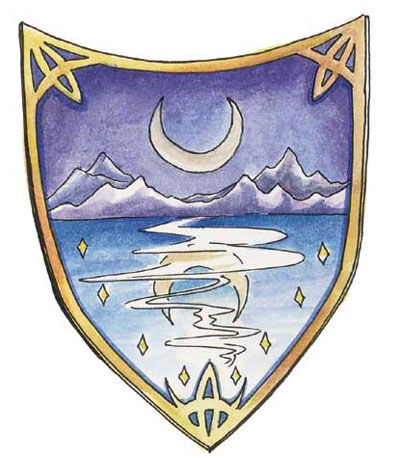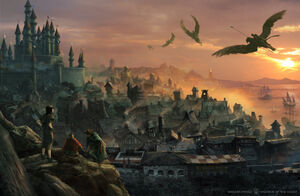Waterdeep (Water- deep)
Waterdeep, also known as the City of Splendors or the Crown of the North,[11] was the most important and influential city in the North and perhaps in all Faerûn. It was a truly marvelous cosmopolitan city of great culture that attracted the most talented artisans, artists, and scholars from across the Realms, as well as a commercial hub for financial interests along the coast and beyond.[1][12]
It was one of if not the most powerful and influential member-states of the Lords' Alliance, the coalition of nations and city-states that sought to maintain order along the Sword Coast and the North.[13]
Structure
Waterdeep was ruled by a sixteen-seat council whose membership was largely secret. These hidden Lords of Waterdeep maintained their identities behind magical masks, called the Lord's Helm, and while they ruled in public, none knew the true identities of most of them. The subject of who the Lords were became a common topic of noble conversation, and some considered it a game to discover the Lords' identities, a game made more confusing by the fact the Lords themselves set their own rumors afloat.[1]
The City Watch was the local police force[1] whose duty it was to capture criminals, settle petty disputes, give directions, summon medical and priestly aid, generally performing duties that promoted the idea that Waterdeep was a city open to all who knew how to behave themselves.[19]
Rulings on the city's laws were issued by the Magisters, more commonly referred to as Black Robes. They had the duty of running the courts and issuing sentences to those they were found guilty.[20] The Black Robes were each protected at least six members of the City Guard while traveling the streets of Waterdeep.[21] Those who were convicted could request trial by the Lord's Court and appeal to the masked lords themselves,[20] but faced strict punishment if their claims were ruled as frivolous.[22]
Culture
Given its size and influence, Waterdeep was a cosmopolitan city with a diverse population of citizens. While humans comprised the majority of its populace, it was home to large number of elves, predominantly moon elves, dwarves, lightfoot halflings, half-elves and gnomes. Waterdhavians tended to be social, stalwart and outspoken people who maintained a worldly perspective of the cultures throughout Toril.[12] While they were proud of their realm's history, they typically kept from dismissing cultures from foreign lands. While they often sought the improvement of their lives through the accumulation of wealth and self-importance, as a people, they would not stand for military conquest or the thought of imperialization.[33]
Fashion
Waterdhavian culture was called for a sort of resigned display of status when it came to the clothes one would wear. While all manner of dress could be seen on the city streets, guild members would only don their livery when conducting official business or meetings, during important holidays or while on ventures outside Waterdeep proper. Nobles would only display their crests or coat-of-arms in subtle affectations, such as a signet ring or other understated jewelry, while their servants wore clothes that were fully emblazoned with their house heraldry.[33] In contrast, women were known to maintain a high sense of fashion, often wearing elegant silk gowns, furs and sparkling jewelry, as the season dictated.[33]Assets
- Sun
- Gold Dragon
- Sambar
- Shards
- Nibs
History
The region that would later be called Waterdeep was originally a trading stop utilized by the local tribesmen of the North and merchants that came up from the cities to the south. Early accounts of permanent farms being established in the area varied slightly, with some sages stating that they were first observed as early as the Year of the Thundering Horde, 52 DR,[54] while others noted their appearance circa to mid–4th century DR.[55]
The actual name "Waterdeep" was first used circa the 10th by sea captains to refer to the warlord-controlled town at whose port they docked. It did not become a true city until the Year of the Nightmaidens, 1032 DR, the year Ahghairon became the first Lord of Waterdeep, and the date from which Northreckoning is counted.[55]
Its size and population grew at a tremendous pace. By the mid–13th century Waterdeep's famous guilds had taken root in the city and construction of the City of the Dead graveyard had been completed. Waterdeep's guild masters seized control of the the City of Splendors shortly after the Year of the Cockatrice, 1248 DR, beginning an era of great turmoil and political conflict referred to as the Guildwars. This dark period ended after a couple decades, and the more modern form of governance was put in place in the Year of the Wagon, 1273 DR. The secretive Lords of Waterdeep took power, aided by the diligent and astute Blackcloaks.[55][1]
People from all across Faerûn and beyond traveled to Waterdeep to take their chance at earning wealth and renown. They were afforded their chances by the city's stable and fair system of government, its stalwart defenders of the City Guard and vigilant members of the Watch. By the 14th century, Waterdeep earned the reputation as a place of tolerance for the myriad of different cultures, lifestyles, and religions that were associated with the people of the Realms.[55][1][20]
When the Time of Troubles came upon Toril in the Year of Shadows, 1358 DR, Waterdeep became the battleground of the gods. The goddess Shar orchestrated the abduction of Luna, the avatar of moon-goddess Selûne, and masqueraded as her in the city. Selûne was freed by the efforts of Luna's adventuring companions and proceeded to defeat Shar and prevent any great destruction from befalling Waterdeep.[56][57] That same year saw the avatar or Myrkul and his legion of night riders invade the city in pursuit of the mortal Midnight, who possessed one of the Tablets of Fate.[58] The Lord of the Dead was disintegrated atop Blackstaff Tower by Midnight in a great battle that led to the opening of the Celestial Staircase atop Mount Waterdeep, and the ascension of three mortals to deific status: Cyric, Kelemvor, and the restored Mystra.[59][60][61]
While Waterdeep did not face ruin as some other cities did when the Spellplague struck the Realms in the Year of Blue Fire, 1385 DR, the magical network that wound through its infrastructure was greatly altered. The cataclysm "awakened" the remaining Walking Statues that previously only existed on the Ethereal Plane and brought them back to Waterdeep on the Prime Material plane. They each ran rampant in the city, causing some extent of destruction before they were stopped by various means.[62]
Waterdeep was struck with another catastrophic event in the Year of Silent Death, 1395 DR, when the Putrescent Anathema spread throughout its region of the North. The plague hit Goldenfields particularly hard, destroying much of the city's primary grain supply. The catastrophe reduced the city's population greatly, hitting its poorer citizens particularly hard.[63]
In the Year of Three Ships Sailing, 1492 DR[note 3], a number of agents and organizations including the shady Xanathar's Thieves' Guild, the greedy Zhentarim, the enigmatic Harpers, and even the stalwart Lords' Alliance sought to recover a cache of 500,000 gold dragons that was hidden somewhere within the city, a sum that was embezzled by the ousted former Open Lord of the city, Dagult Neverember.[64]

Type
Geopolitical, City-state
Alternative Names
City of Splendors, Crown of the north
Demonym
Waterhavian, Waterdavian
Currency
- Sun
- Gold Dragon
- Sambar
- Shards
- Nibs
Legislative Body
The Lords of Waterdeep
Judicial Body
The Magisters of Waterdeep
Related Species
Remove these ads. Join the Worldbuilders Guild










Comments